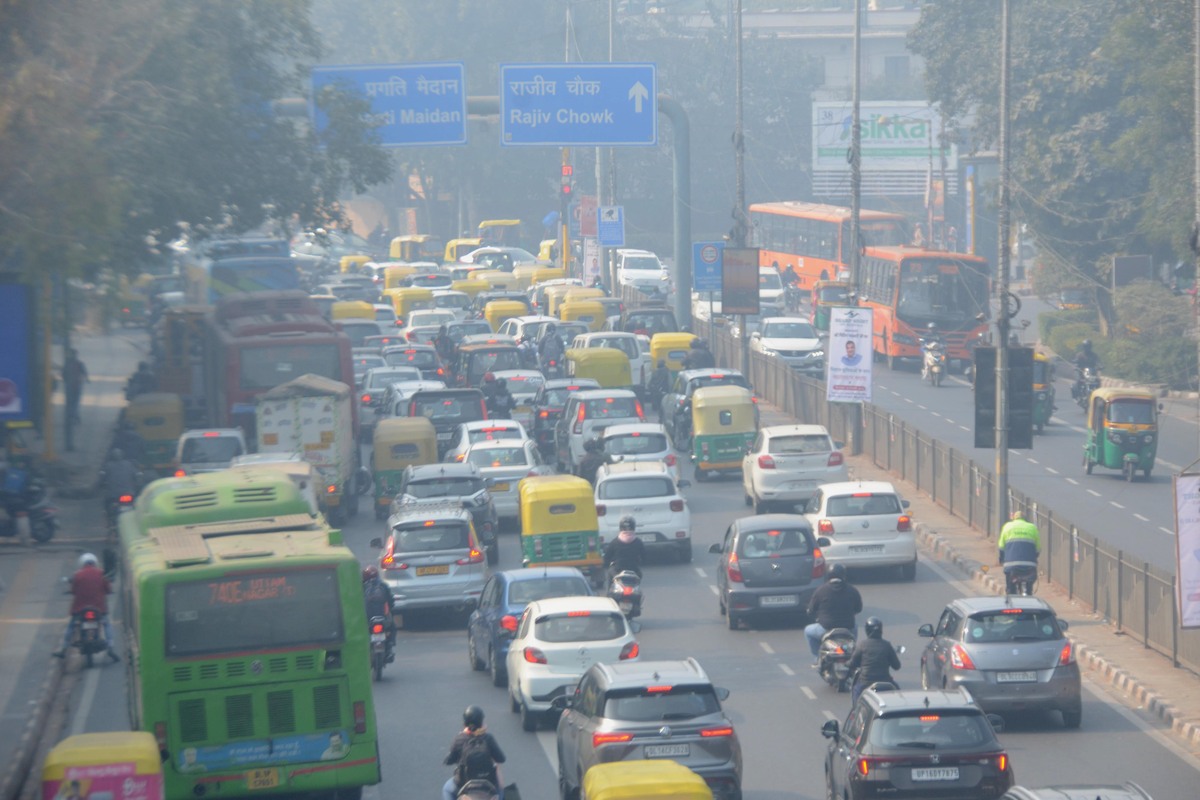Delhi witnesses strong surface winds, rain at several places
Several parts in the city also witnessed rain with the strong winds, the regional meteorological centre said in its bulletin.
India Meteorological Department (IMD) Scientist Soma Sen addressed the prevailing weather conditions in Delhi and North India, highlighting the minimal change expected in the minimum temperature on Tuesday.

Traffic Jam on a foggy afternoon, in the capital (Photo:Subrata Dutta)
India Meteorological Department (IMD) Scientist Soma Sen addressed the prevailing weather conditions in Delhi and North India, highlighting the minimal change expected in the minimum temperature on Tuesday.
“In Delhi and in North India, we are not expecting much change in the minimum temperature. Maybe a one-degree rise is likely because of the sunny skies, but foggy conditions will persist. Low cloud conditions may also continue for the neighbouring regions, because of which Haryana and Punjab will see severe cold day conditions for the next two to three days… We are not expecting any sudden change in either temperature or cold conditions… The intensity of the cold will gradually decrease, which is a seasonal effect…” IMD Scientist Soma Sen said.
Despite a gradual decrease in cold intensity, Sen projected ongoing foggy mornings, cold days, and cold wave conditions across the plains for at least the next two days.
“In terms of weather right now, fog is the most dominant phenomenon, because of which we have seen road, railway, and aviation affected. Simultaneously, we are also seeing associated with the fog severe cold day conditions have been realised throughout north India and because we had a couple of days of clear sky’s minimum temperature has also dropped and we are seeing cold wave conditions also over many parts of north India” she said.
Advertisement
“For the plains, we expect this kind of weather to continue, which is foggy mornings, cold day and cold waves. Both conditions will persist over the plains of north India for a minimum of two days after which the minimum temperature may show a slight rise because of which we are expecting some amelioration in the cold conditions,” she added.
Sen also explained the absence of strong western disturbances, resulting in a lack of moisture flow from the Arabian Sea, a crucial factor in North Western winter weather.
“Very feeble western disturbances are moving. These are likely to give some isolated light rainfall activity over the western Himalayan region mainly tomorrow; snowfall will also occur, but not wide-spread rainfall or snowfall activity,” she said.
“We are expecting this kind of cold weather to prevail over north India for the next 3 to 4 days at least, beyond which we will be keeping you updated,” she added.
On Tuesday morning, dense to very dense fog was reported over Delhi, Haryana, Punjab and Eastern Uttar Pradesh, with cold wave to severe cold wave conditions prevailing over most parts of Haryana, Chandigarh, and Delhi, the Meteorological Department said.
According to the IMD, ‘very dense’ fog is when visibility is between 0 and 50 metres, 51 and 200 metres are ‘dense’, 201 and 500 metres are ‘moderate’, and 501 and 1,000 metres are ‘shallow’.
Airport authorities said that around 30 flights departing from Delhi’s Indira Gandhi International (IGI) airport were delayed, while 17 flights were cancelled due to weather conditions.
Dense fog was reported over Jammu Division with a visibility of 50 metres at Jammu airport and over Sub-Himalayan West Bengal and Sikkim.
A total of 30 trains bound for Delhi were also delayed due to the low visibility caused by fog.
Meanwhile, severe cold wave conditions also prevailed over many parts of Punjab, in isolated pockets of East Madhya Pradesh, northwest Rajasthan and west Uttar Pradesh.
In Punjab’s SBS Nagar, a 0.4-degree Celsius minimum temperature was recorded in Ballowal Saunkhri.In Haryana, Mahendragarh recorded 0.7 degrees Celsius, Hisar recorded a minimum of 1.1 degrees Celsius and at Panchkula, the minimum temperature recorded was 1.8 degrees Celsius. Ganganagar in Rajasthan recorded a minimum temperature of 4.3 degrees Celsius.
At 8:30 am today, Ayanagar and Safdarjung in the national capital recorded visibility of 25 metres each, while the Ridge and Palam areas recorded visibility of 50 metres each.
According to the India Meteorological Department, Varanasi in Uttar Pradesh reported 0 metres of visibility at 5:30 am today, while the state capital, Lucknow, reported 25 metres of visibility. Gwalior in West Madhya Pradesh recorded a visibility of 50 metres.
On January 16, the lowest minimum temperature of 1 degree Celsius was reported at Ludhiana (Punjab) over the plains of the country.
Advertisement